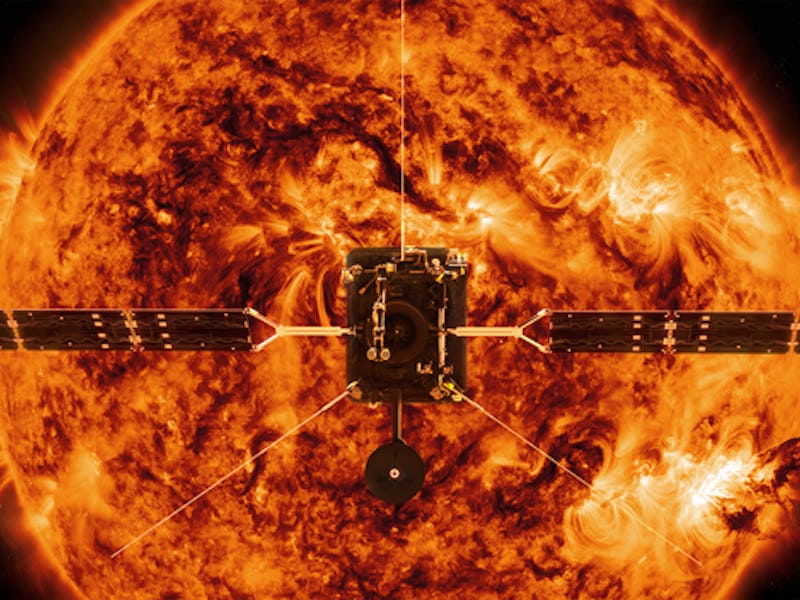Solar Orbiter will take the closest images of the Sun ever captured
The spacecraft just made its first close approach to the star.

On Monday, a spacecraft built to withstand the scorching heat of the Sun survived its first close encounter with the star.
The Solar Orbiter, the spacecraft carrying out a collaborative mission between NASA and the European Space Agency (ESA), made its first close approach to the Sun, getting as close as 48 million miles to the star's surface, which is around half the distance between the Sun and the Earth.
The spacecraft launched on February 9, 2020 with the Sun as its destination, getting up close and personal with our host star in order to resolve some of the lingering mysteries regarding the Sun's magnetic field, solar storms and how the star affects its surrounding space environment.
The spacecraft is essentially flying outside the confines of the Solar System in order to peer down at the Sun, studying the star from a high altitude.
The Solar Orbiter will travel in an elliptical orbit around the Sun, completing one orbit every 168 days.
This week marked the spacecraft's first perihelion, the point in orbit closest to the Sun. Following its close approach, the team of engineers behind the Solar Orbiter will test out the spacecraft's ten science instruments for the first time since its launch.
Using the six telescopes onboard the Solar Orbiter, the team will be able to capture the closest images of the Sun ever.
“We have never taken pictures of the Sun from a closer distance than this,” Daniel Müller, ESA’s Solar Orbiter Project Scientist, said in a statement.
In January, the National Science Foundation's Daniel K. Inouye Solar Telescope captured the highest-resolution close-up images of the Sun's surface (and those were quite stunning), but the images were obtained from an Earth-based telescope with the planet's atmosphere getting in the way.
However, the images captured by the Solar Orbiter will be taken from space thereby showing parts of the solar spectrum that you cannot capture from Earth.
“For the first time, we will be able to put together the images from all our telescopes and see how they take complementary data of the various parts of the Sun including the surface, the outer atmosphere, or corona, and the wider heliosphere around it,” Müller said.
The images will be released to the public in mid-July.
Since the spacecraft is currently 134 million kilometers away from Earth, it will take about a week for the images to be downloaded before being processed by the team of scientists on the ground.
A breakdown of the different instruments onboard the Solar Orbiter.
In addition to the telescopes, the Solar Orbiter also carries four in-situ instruments, which will measure solar wind, plasma, and other aspects of the environment around the spacecraft.
“For the in-situ instruments, this is not just a test, we are expecting new and exciting results," Yannis Zouganelis, ESA’s Solar Orbiter Deputy Project Scientist, said in a statement. “This is the first time that our in-situ instruments operate at such a close distance to the Sun, providing us with a unique insight into the structure and composition of the solar wind.”
The data from the in-situ instruments will be released to the public later this year.
The Solar Orbiter will make its second perihelion in early 2021. A year later, the mission will officially commence its science phase with its first close approach scheduled for early 2022, where the spacecraft will be as close as 26 million miles to the Sun's surface (getting closer to the Sun than the Solar System's innermost planet, Mercury).
Temperatures at that distance can reach some 1,000 degrees Fahrenheit — 13 times what any satellite in Earth orbit could experience. In order to make its mission possible, scientists developed a special black coating for the orbiter that will help it stand the heat:
"Paint it black": ESA's Solar Orbiter at IABG in Ottobrunn, Germany in October 2019.
NASA's Parker Solar Probe will get even closer to the Sun, a record-breaking distance of around 4 million miles from the Sun's surface. The spacecraft launched in 2018, and will reach its closest approach by June, 2025. But alas, the spacecraft does not carry telescopes that are capable of capturing close-up images of the star.
The solar duo will work together to try and enhance scientists' understanding of our host star.